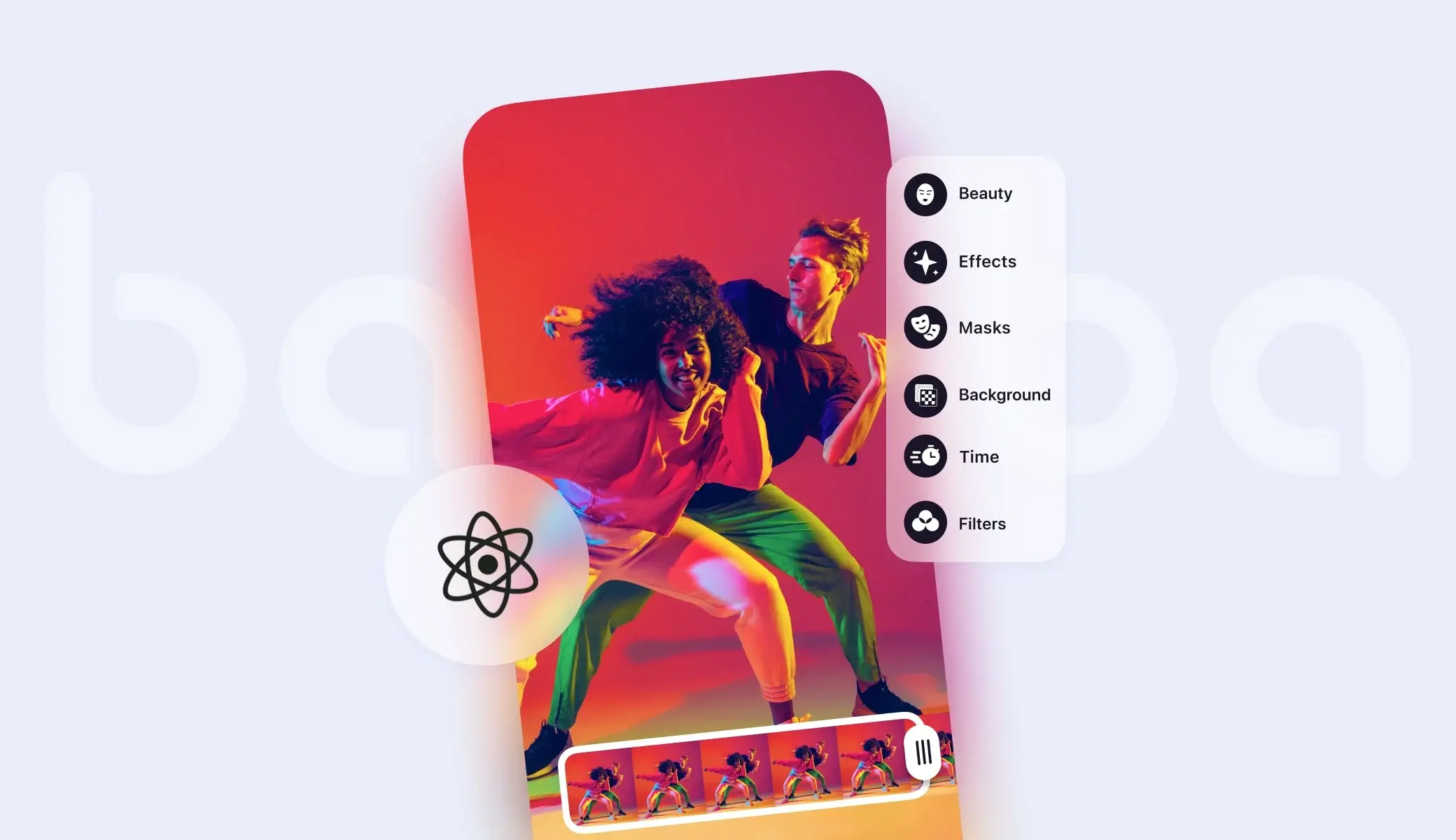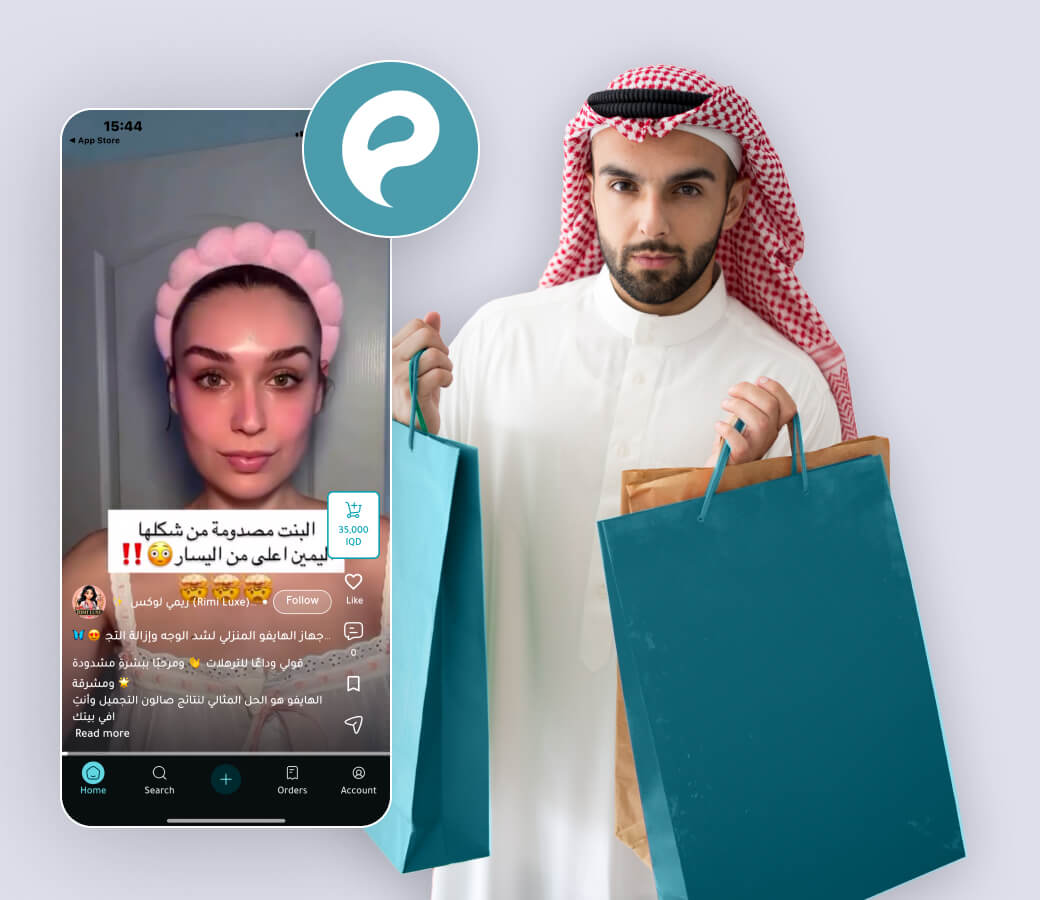5 Best React Native Video Player Libraries in 2025
You’ve got the big idea. The user flow is mapped. And now it’s time to add one of the most crucial pieces: video. Not just a static player, but a video experience that feels modern, fluid, and native. That means no stutters, no clunky controls, and definitely no one-size-fits-all solution.
React Native, now powering nearly 13% of the top 500 apps in the U.S., including giants like Instagram and Bloomberg, continues to be a go-to framework for building performant cross-platform apps. As the framework grows, so does the demand for seamless solutions, including React Native video player libraries that just work across devices.
A wave of new libraries and SDKs has emerged, offering everything from lightweight players to full-fledged video editing solutions with AR features, filters, and real-time effects. But with so many choices, how do you know which one fits your project?
In this article, we’ll explore the 5 best React Native video player libraries in 2025.

[navigation]
TL;DR:
- Libraries are collections of prebuilt features that help developers save time on finishing their products;
- Top 5 React Native video player libraries include Banuba Video Editor SDK, react-native-video, Video.js, Video-React, and VidStack;
- To choose the most fitting one, clearly define your mission, note the libraries that support your chosen video formats, take into account the flexibility you're getting, consider performance, see whether there is an active community around the library, and weigh the cost against the benefits the specific product offers.
What Is a React Native Video Player Library?
Here’s a stat to chew on: in 2025, video content is expected to account for 82% of all consumer internet traffic. Translation? If your app doesn’t support video, it’s behind.
React Native video player libraries are collections of prebuilt features. They help devs keep up with that demand. They’re prebuilt tools that let you add, control, and style video content inside your app without starting from zero.

When selecting a library, you’ll quickly see a clear division between open-source and commercial SDKs.
- Open-source libraries are ideal for straightforward tasks, rapid prototyping, or if you need complete access to the code. These libraries benefit from active communities but might not offer advanced capabilities, dedicated support, or optimized performance right away.
- Commercial SDKs are designed for teams who need more than just playback. These tools often come with advanced capabilities (like editing, effects, transitions, face filters, AR, export options) and are built for production-scale apps. They also usually include professional support and ongoing updates, which can save tons of dev hours down the road.
In short: if you just need a simple video viewer, open-source can do the job. But if your app depends on video as a core feature or you want a polished, TikTok-level experience, commercial SDKs might be the better route.
Top 5 Libraries in 2025
Whether you're building the next viral social app or a high-performance OTT platform, the right React Native video player library makes all the difference. Here's a look at the best tools available this year, each one packed with unique powers for different needs.
1. Banuba Video Editor SDK – Full-Stack Editing Toolkit
Imagine this: a user opens your app, spends minutes crafting a polished video (stitched, filtered, beautified, captioned) and exports it ready to share. That’s the Banuba magic.
What sets Banuba apart?
- Comprehensive video editing suite: trimming, time effects (slow-mo, rapid), color filters, transitions, PiP, text and GIFs, etc.;
- Advanced AI and AR capabilities: face AR masks (3D masks, 2D sticker, trigger effects, etc.), beauty effects, background swap and background subtraction, plus a constantly growing effects library;
- Flexible pricing: the license cost depends on the feature set, platform support, and MAUs, making it affordable to mid-sized companies and startups as well as established enterprises.
Why devs love it:
- Small SDK size: adds just 30 Mb to the app;
- Quick integration: sometimes in less than 8 minutes;
- Simple feature implementation with clear docs;
- Fully customizable UI to keep your branding front and center;
- Perfect for social-style editing apps, yet powerful enough for pro-grade video tools.
Their SDK pricing is flexible and typically follows a per-app license, with usage tiers for AR features. Developers can integrate a white-label creative editor, and costs vary depending on customization and usage needs. A 14-day free trial is generally available on request to explore the SDK. In addition, Banuba Video Editor SDK is supported by comprehensive documentation and sample projects on GitHub, allowing you to explore its capabilities even before starting the free trial.
By the way, Banuba helped Uhive, a social media platform, improve their users’ content creation process. Plus, they’ve helped the social network Press Sports reduce the price of integrating a high-quality video editor into their product. So, if they can do such things, imagine what they could help your app pull off. Got interested? Then read how to integrate Banuba’s SDK into your platform.
2. react-native-video – The Backbone of Everyday Playback

For applications requiring versatile video playback, from engaging workout tutorials and comprehensive online courses to short, impactful clips, react-native-video stands out as a powerful and widely adopted solution within the React Native ecosystem.
Key strengths:
- Supports local and streamed videos in MP4, HLS, DASH formats
- Easy integration with custom controls, subtitles, and Picture-in-Picture (PiP)
- Works seamlessly on iOS, Android, and even tvOS
- Lightweight and flexible
- Native React Native support
- Huge community backing
Why it’s so popular:
- Massive open-source community: 28,000+ GitHub stars and growing
- Comprehensive docs and active maintenance
- Highly customizable yet lightweight, no bloat here
Cons:
- No built-in UI. You can build your own controls. However, it all depends, as this is often seen as a pro by developers who need a highly customized video player. But still, it does mean more upfront development effort.
- Advanced features like DRM or analytics need manual setup
So, react-native-video is a cornerstone library for React Native developers seeking robust, adaptable, and performant video playback capabilities. You can find more about it here.
Because react-native-video is under the MIT License, it’s free to use and modify for any project, personal or commercial, with no licensing fees. That said, features like custom UI designs, DRM, or analytics aren’t included out of the box and will require extra development time.
3. Video.js – Streaming Backbone for High-Traffic React Native Apps
When it comes to serious live streaming, like concerts, webinars, or breaking news, Video.js is a battle-tested giant in the web video space.
Why it’s powerful:
- Native support for HLS, MPEG-DASH, and live events
- HTML5 core guarantees wide compatibility
- Plugin-rich ecosystem with ads, analytics, closed captions, and more
- Proven scalability: trusted by media giants and OTT platforms worldwide
React Native integration:
- Embedded through WebView or community wrappers
- Best suited for hybrid apps mixing React Native with web technologies
Cons:
- Requires WebView embedding, heavier than native players
- Slightly more complex setup
Video.js is licensed under Apache License 2.0, which means the core player is free to use. However, commercial plugins or services, such as DRM, analytics, or ad integrations, may require separate payments.
Got interested? You can find some React and Video.js Player code snippet examples here.
4. Video-React – React-Focused Video Playback with Flexibility

Love React’s declarative style? Video-React is built with JSX and React state management in mind, offering a component-first approach perfect for web and hybrid apps.
Highlights:
- Includes all core playback controls: fullscreen, captions, seek bar, progress UI
- Easily extensible via props and hooks
- Great for cross-platform apps sharing React web and React Native codebases
- Fully React-friendly architecture
- Developer-friendly and easily customizable
React Native note:
- Web-focused, requires WebView wrappers for mobile
- Ideal for apps mixing web views with native code
Cons:
- Requires WebView for React Native
- Lacks advanced native features like DRM or PiP
Video-React is free to use under the MIT License, whether for personal projects or business. But if you plan to use extra tools like KendoReact alongside it, those might have their own prices.
If you want to give it a try, learn how to install the Video-React library here.
5. VidStack – Developer-Friendly Media Player Library

While VidStack's primary focus has been on providing a fantastic web-based experience with its multi-framework support, its architecture and underlying principles make it an interesting contender to consider for React Native development.
Potential for React Native:
- Headless UI Approach: VidStack is "headless," meaning it gives you the engine for playing media, but you design all the buttons and controls yourself.
- Multi-Platform Consistency: If you’re building both a web app and a mobile app, VidStack’s shared core logic offers a chance to streamline development. By reusing its API concepts across platforms, you could simplify maintenance, reduce duplication, and create a more cohesive user experience. But still, this consistency is more in the underlying logic and API concepts rather than direct UI code sharing.
- Room for Growth: VidStack is designed to be extended. It's possible that in the future, people might create special "connectors" (like bridges or native modules) that let VidStack work even better with the built-in video players on iPhones and Androids, making it faster.
Cons:
- Not Ready-Made for Native: Right now, VidStack doesn't have a simple, built-in way to work directly with the video players on phones like react-native-video or Banuba do. You'd likely have to do some extra work to connect it, maybe even using a web window inside your app (WebView).
- Performance: If you use a web window (WebView) to run VidStack in your React Native app, it might not be as fast or smooth as using tools built specifically for phone apps.
- Community and Documentation: Because VidStack is newer to the React Native world, there might not be as many people using it or as many guides and examples available compared to more established React Native video players.
VidStack is licensed under the MIT License as well. Therefore, there are no direct licensing fees associated with using VidStack. Any costs would arise from the development effort required to integrate it into a React Native environment, especially given its current web-first focus and the potential need for WebView wrappers or custom native modules.
So, VidStack could be interesting for React Native apps because it lets you build your own look and might offer some shared logic with web versions in the future. Keep an eye on it, as it might get better for mobile apps over time. And for now, explore some of its examples here.

How to Choose the Right React Native Video Player Library

Step 1: Know Your Mission
Are you streaming live concerts or just playing simple clips? Basic playback? Editing magic? Nail your app’s core needs and ideas first.
Step 2: Formats & Streaming Matter
MP4, HLS, DASH — make sure your player speaks your video’s language. Live streaming? Look for smooth adaptive protocols.
Step 3: Customize Like a Pro
Want your player to scream your brand or just default controls? Pick a library that lets you flex your design muscles.
Step 4: Speed & Smoothness
Native modules equal smooth playback. Avoid lag, glitches, or clunky WebViews slowing you down.
Step 5: The People Factor
Big, active communities mean quick fixes and fresh updates. Solid docs means fewer headaches.
Step 6: Budget Wisely
Free and open-source or enterprise-level with premium features? Choose what fits your wallet and needs.
Common Challenges and Best Practices
Building great video experiences in React Native means navigating a few tricky spots. Here are the top ones and how to handle them:
- Playback performance: Slow or choppy videos kill UX fast. Use native modules and hardware acceleration. Test on real devices, not just simulators. Adaptive streaming (HLS/DASH) helps keep playback smooth by adjusting quality on the fly.
- Video formats: MP4 is king for broad support, but don’t forget about streaming formats like HLS for live or adaptive video. WebM can be great on Android but doesn’t work on iOS. Plan to serve fallback formats or use conversion tools like FFmpeg.
- Custom controls and UI: Default controls often don’t fit your app’s style. Build your own UI components and sync them to playback events. Keep buttons big, clear, and responsive.
- State and events: Managing play, pause, buffering, and errors is essential. Use React’s state or Redux to track video status, and subscribe to player events to update UI or trigger actions.
- Debugging on Android & iOS: Each platform has its quirks. Use debugging tools like Flipper and React Native Debugger. Profile performance with Android Profiler and Xcode Instruments. Stay current with library updates and community fixes.
Final Thoughts
In 2025, video isn’t optional but expected. Whether your app is built for creators, learners, shoppers, or streamers, delivering a smooth, native video experience is no longer a nice-to-have but mission-critical. Fortunately, the React Native ecosystem has stepped up with a wide spectrum of video player libraries, from lean open-source tools to fully loaded commercial SDKs like Banuba.
So, start with your app’s goals. If your users just need to press play, lightweight solutions like react-native-video or Video.js might be all you need. But if video is at the heart of your experience (editing, effects, AR, or real-time engagement), investing in a powerful SDK like Banuba’s Video Editor SDK can pay off massively in user satisfaction and dev velocity.
Your video player can make or break the feel of your app. Choose wisely, test thoroughly, and don’t settle for clunky. A polished, seamless experience could be the difference between a user watching once or coming back again and again.
References
Banuba. (n.d.-a). GitHub - Banuba/ve-sdk-android-integration-sample: Integrating Banuba Video Editor SDK with an Android app. Code samples, dependencies, customization options, etc. GitHub. https://github.com/Banuba/ve-sdk-android-integration-sample
Banuba. (n.d.-b). GitHub - Banuba/ve-sdk-flutter-integration-sample: How to integrate Banuba Video Editor with a Flutter app - for iOS and Android. GitHub. https://github.com/Banuba/ve-sdk-flutter-integration-sample
Banuba. (n.d.-c). GitHub - Banuba/ve-sdk-ios-integration-sample: Integrating Banuba Video Editor SDK with an iOS app. Code samples, dependencies, customization options, etc. GitHub. https://github.com/Banuba/ve-sdk-ios-integration-sample
Banuba. (n.d.-d). GitHub - Banuba/ve-sdk-react-native-cli-integration-sample. GitHub. https://github.com/Banuba/ve-sdk-react-native-cli-integration-sample
Insivia. (2025, February 14). Video Marketing Statistics You Must know in 2025. Insivia. https://www.insivia.com/video-marketing-statistics-you-must-know-in-2025
Krasko, A. (2024, November 6). $2m raised and 8x more college offers for sports social network. https://www.banuba.com/blog/usd-2m-in-investment-and-8x-more-college-offers
Mattingly, N. (2025, January 27). Council Post: The future is here: It’s time to scale your business with video. Forbes. https://www.forbes.com/councils/forbesbusinesscouncil/2025/01/27/the-future-is-here-its-time-to-scale-your-business-with-video/
Ranaweera, B. (2025, March 4). React Native vs Flutter: Which Saves More Development Time in 2025? Blott Studio. https://www.blott.studio/blog/post/react-native-vs-flutter-which-saves-more-development-time
React and Video.js. (n.d.). Video.js. https://videojs.com/guides/react/
React Native video. (n.d.). TheWidlarzGroup Docs. https://docs.thewidlarzgroup.com/react-native-video/
Redirecting. (n.d.-a). https://www.google.com/url?q=https://www.banuba.com/blog/video-editor-for-an-innovative-social-network
Redirecting. (n.d.-b). https://www.google.com/url?q=https://www.banuba.com/blog/integrating-banuba-video-editor-sdk-with-a-react-native-app
Redirecting. (n.d.-c). https://www.google.com/url?q=https://github.com/videojs/video.js/blob/main/LICENSE
Team, B. (n.d.). AI Video Editor SDK API for Android, IOS. https://www.banuba.com/video-editor-sdk
Video-React - React Video component. (n.d.). https://video-react.js.org/
Vidstack. (n.d.). GitHub - vidstack/examples: Examples on how to use Vidstack with your favourite JS and CSS libraries.GitHub. https://github.com/vidstack/examples
What is MIT License? (n.d.). https://memgraph.com/blog/what-is-mit-license






